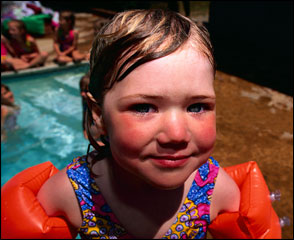|
 A new study led by researchers at the Colorado School of Public Health at the University of Colorado Denver shows that very light-skinned children who tan appear to develop more moles on the skin than children who don't tan. The presence of these moles is the strongest risk factor for melanoma development. A new study led by researchers at the Colorado School of Public Health at the University of Colorado Denver shows that very light-skinned children who tan appear to develop more moles on the skin than children who don't tan. The presence of these moles is the strongest risk factor for melanoma development.
Cutaneous melanoma ranks sixth in incidence of all cancers among men and women in the U.S. The authors cite studies that found much of the preventable risk for melanoma is established in childhood, and developing habits around sun exposure and protection is particularly important early in life.
In Colorado, high elevation combined with more than 300 days of sunshine a year means residents have increased exposure to UV rays, resulting in a melanoma incidence rate approximately 30 percent higher than the national average.
"The number and size of nevi, also known as moles, are often used for determining the risk of developing melanoma," said Lori Crane, Ph.D., chair of the department of community and behavioral health at the Colorado School of Public Health and principal investigator on the study. "The risk factors for melanoma development and higher nevus counts include lighter hair color, eye color and skin color, greater UV exposure, higher frequency and severity of sunburns, and freckling."
The study is published in the September issue of Archives of Dermatology, one of the Journal of the American Medical Association (JAMA)/Archives journals, and was supported in part by a grant from the National Cancer Institute.
|